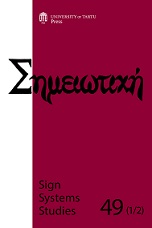Towards an integration of two aspects of semiosis – A cognitive semiotic perspective
Towards an integration of two aspects of semiosis – A cognitive semiotic perspective
Author(s): Piotr KonderakSubject(s): Semiology
Published by: Tartu Ülikooli Kirjastus
Keywords: cognitive semiotics; meaning-making; cognitivism; enactivism; embodiment; the Amalgamated Mind approach; Peircean semiotics;
Summary/Abstract: Meaning-making processes, understood hierarchically, in line with the Semiotic Hierarchy framework, change on various timescales. To account for and predict these changes, one can take a cognitive view on semiosis. I adopt an interdisciplinary approach combining semiotic studies and cognitive studies in an attempt to account for meaning-making activity and to predict the course of semiosis. In this context, I consider meaning-making activity as shaped by both “external” (to a semiotic system) as well as “internal” factors. I also show how both the “external” and “internal” sources of the dynamicity of meaning-making should be framed in terms of studies on cognition. I start with a non-standard, 4e approach to meaning-making. According to this framework, meaning-making processes are constituted by (and not just dependent on) environmental and bodily factors. The dynamicity of semiosis can be accounted for in terms of an experiencing, embodied subject (agent) enacting her/his/its own domain of meaningful phenomena. As I argue, this perspective on meaning-making is the cognitive foundation of the first two levels of the Semiotic Hierarchy. In the following sections I present the Peircean view on signs and semiosis, according to which semiosis is a result of the very nature of a sign and a sign system. In this view, the dynamicity of semiosis has primarily “internal” sources: it stems from the unavoidable fallibility of interpretation and synechism of signs. As I show, this aspect of semiosis can be addressed by means of standard (cognitivist) cognitive science and by means of cognitive modelling. Ultimately, I sketch a proposal of an attempt to develop a uniform cognitive framework allowing for integration of the above-mentioned aspects of semiosis – a framework based on Rowlands’ idea of the Amalgamated Mind.
Journal: Σημειωτκή - Sign Systems Studies
- Issue Year: 49/2021
- Issue No: 1-2
- Page Range: 132-165
- Page Count: 34
- Language: English

